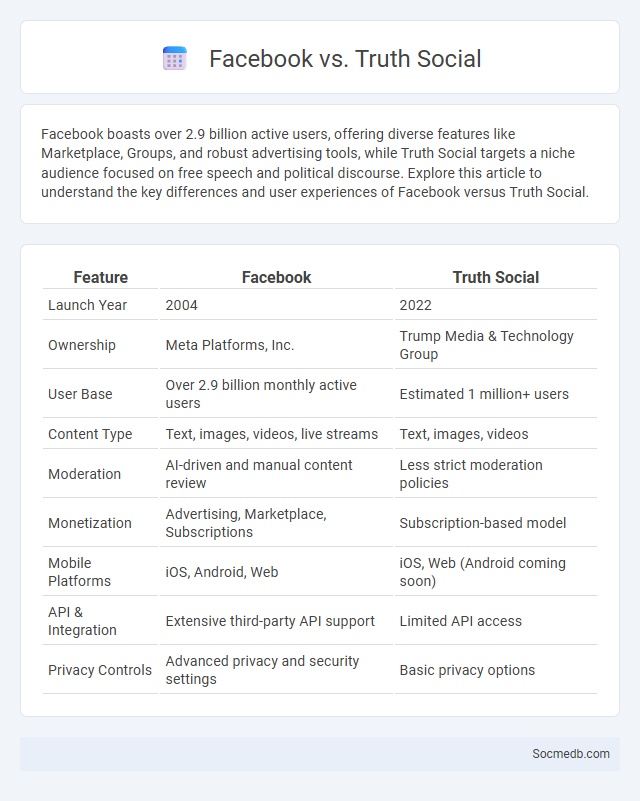
Photo illustration: Facebook vs Truth Social
Facebook boasts over 2.9 billion active users, offering diverse features like Marketplace, Groups, and robust advertising tools, while Truth Social targets a niche audience focused on free speech and political discourse. Explore this article to understand the key differences and user experiences of Facebook versus Truth Social.
Table of Comparison
| Feature | Truth Social | |
|---|---|---|
| Launch Year | 2004 | 2022 |
| Ownership | Meta Platforms, Inc. | Trump Media & Technology Group |
| User Base | Over 2.9 billion monthly active users | Estimated 1 million+ users |
| Content Type | Text, images, videos, live streams | Text, images, videos |
| Moderation | AI-driven and manual content review | Less strict moderation policies |
| Monetization | Advertising, Marketplace, Subscriptions | Subscription-based model |
| Mobile Platforms | iOS, Android, Web | iOS, Web (Android coming soon) |
| API & Integration | Extensive third-party API support | Limited API access |
| Privacy Controls | Advanced privacy and security settings | Basic privacy options |
Understanding the Rise of Facebook and Truth Social
Facebook's exponential growth stemmed from its user-friendly interface and powerful social networking features, allowing billions to connect effortlessly worldwide. Truth Social emerged as a response to perceived censorship, emphasizing free speech and attracting users seeking alternative platforms. Understanding these dynamics helps you navigate the evolving digital landscape and choose platforms aligning with your values.
Fake News: Definition and Modern Impact
Fake news refers to deliberately fabricated information that mimics legitimate news formats to deceive readers and spread misinformation. On social media platforms, fake news can quickly go viral due to algorithms prioritizing engagement over accuracy, leading to widespread public confusion and erosion of trust in credible sources. The modern impact includes influencing political opinions, undermining public health efforts, and polarizing societies globally.
How Facebook Battles Fake News
Facebook employs advanced artificial intelligence algorithms to detect and reduce the spread of fake news by analyzing patterns, sources, and user behavior. Your experience is enhanced through community reporting tools and partnerships with fact-checking organizations that verify content accuracy. Continuous updates to these systems aim to improve the identification and removal of misleading information, safeguarding platform integrity.
Truth Social’s Approach to Misinformation
Truth Social employs advanced content moderation algorithms and a robust user-reporting system to combat misinformation effectively. You benefit from a platform that prioritizes transparency by fact-checking content and enforcing strict community guidelines against false information. This targeted approach enhances the reliability and trustworthiness of information shared within its social media environment.
Comparing Moderation Policies: Facebook vs Truth Social
Facebook employs advanced AI algorithms combined with human moderators to enforce community standards that target hate speech, misinformation, and harmful content with detailed guidelines. Truth Social prioritizes minimal content filtering, emphasizing free speech while removing only content that violates federal law or incites violence, leading to a higher tolerance for controversial posts. Your understanding of these contrasting moderation policies highlights the trade-off between content control and platform openness.
User Demographics and Platform Influence
Social media platforms exhibit diverse user demographics, with Instagram and TikTok attracting younger audiences primarily aged 18-34, while Facebook maintains a strong presence among users aged 35-54. Platform influence is significant in shaping consumer behavior, with over 70% of millennials relying on social media recommendations before making purchases. Brands leverage targeted advertising and influencer collaborations on these platforms to maximize engagement and conversion rates.
Viral Misinformation: Case Studies on Both Platforms
Viral misinformation on social media platforms such as Facebook and Twitter has led to significant real-world consequences, including public health scares and political unrest. Case studies reveal how false content spreads rapidly through algorithm-driven feeds and user interactions, amplifying misinformation far beyond its original source. You must critically evaluate sources and rely on verified information to mitigate the impact of viral misinformation on these platforms.
Fact-Checking Partnerships and Their Effectiveness
Fact-checking partnerships between social media platforms and independent organizations play a critical role in reducing misinformation by verifying content accuracy and flagging false claims. These collaborations enhance the credibility of information shared on platforms like Facebook, Twitter, and Instagram, helping users make informed decisions while browsing. Your engagement with fact-checked content supports a more trustworthy online environment and promotes digital literacy.
The Role of Algorithms in Spreading Fake News
Algorithms on social media platforms prioritize content based on engagement metrics, often amplifying sensationalist and misleading information that spreads rapidly among users. Your exposure to fake news increases as these algorithm-driven systems favor emotionally charged posts, creating echo chambers that reinforce false narratives. Understanding how algorithms shape your news feed is crucial for critically evaluating the accuracy and reliability of the information you encounter online.
Future Challenges in Combating Misinformation Online
Social media platforms face escalating challenges in combating misinformation due to rapidly evolving tactics like deepfakes and coordinated disinformation campaigns. Advanced AI-generated content complicates detection and verification processes, demanding more sophisticated algorithms and human oversight. Your ability to discern credible sources is crucial as platforms strive to implement real-time fact-checking and stronger regulatory frameworks.
 socmedb.com
socmedb.com